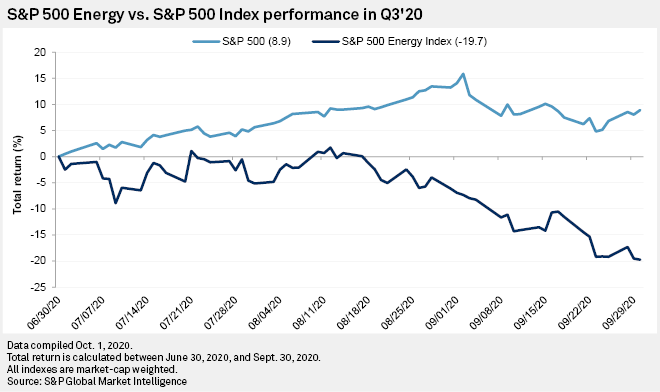It is hard to overstate just how brutal 2020 has been for oil and gas producers, but few things illustrate the difficulties more than a glance at their market capitalization levels since Jan. 1. Slammed by a trio of the COVID-19 pandemic, an oil price collapse and overall investor apathy, some of the best-known names in the industry have seen the value of their companies cut in half in nine months.
No company has been immune to the downturn in value. Even Exxon Mobil Corp., the most powerful of the supermajors, has seen its market cap crushed since the start of the year. On Dec. 31, 2019, the company's market cap stood at $295.25 billion. On March 31, it had tumbled to $160.55 billion. An improvement in oil prices pushed the market cap back up to nearly $189.1 billion at the end of June, but a renewed slide left Exxon's market cap at $145.16 billion on Sept. 30, a decline of more than 50% from the start of the year.
Another supermajor, Chevron Corp., experienced similar results. Its market cap stood at $227.87 billion on Dec. 31, 2019, but fell to $135.28 billion by the end of March. Chevron's market cap rebounded slightly in June but had plunged to $134.44 billion by Sept. 30.

Smaller independents found themselves in the same boat as their larger counterparts. EOG Resources Inc., which had a market cap of $48.73 billion on Dec. 31, 2019, saw its value fall to $20.93 billion on Sept. 30. The company's market cap fell more than 29% in the third quarter and is nearly on par with where it stood on March 31 as of the end of the third quarter.
Prominent Permian Basin producer Concho Resources Inc.'s market cap fell by more than half in the first quarter and has regained only a small portion of its losses over the past six months. The company started the year valued at $17.47 billion and was sitting at $8.62 billion on Sept. 30.
Occidental Petroleum Corp. has endured one of the most painful drops in market cap in 2020. Its high for the year came on Jan. 15, when it topped out at $42.22 billion. As of Sept. 30, that number had fallen to $9.31 billion. The company's market cap has fallen 44.6% since the start of the third quarter.

While nearly every independent saw its market cap fall during the third quarter, a number are in better shape than they were at the end of March, shortly after oil prices dived briefly into negative territory. Diamondback Energy Inc., whose market cap slid nearly 28% in the third quarter, was still 15% above where it was at the end of March when its market cap stood at $4.13 billion. Pioneer Natural Resources Co.'s market cap fell from more than $16 billion June 30 to $14.13 billion at the end of September, but that is still a 22% improvement from where things stood on March 31.
A few independents have seen their market caps rebound significantly since the first quarter. Continental Resources Inc. saw its market cap dive from $12.62 billion on Dec. 31, 2019, to $2.75 billion at the end of March. It has since improved its position by 60% to $4.42 billion, though that remains well below June 30's market cap of $6.31 billion. Apache Corp., which had a market cap of $1.58 billion on March 31, has seen its net value increase 127% to $3.57 billion by the end of September.



